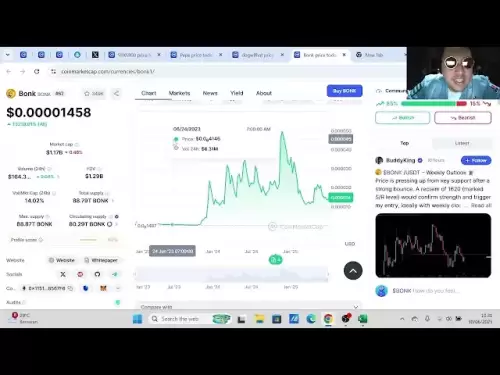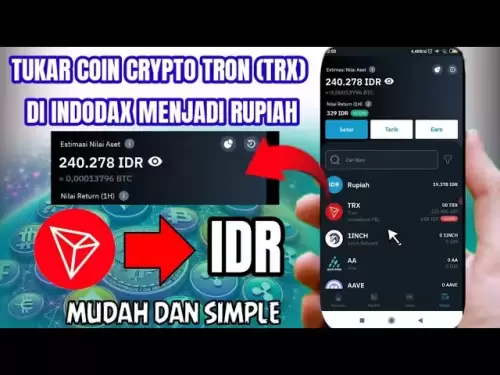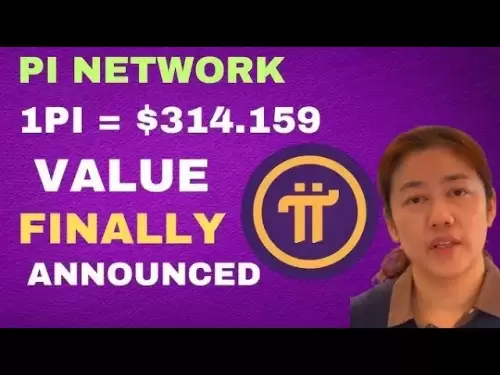-
 Bitcoin
Bitcoin $107,397.3430
-0.20% -
 Ethereum
Ethereum $2,467.5633
1.33% -
 Tether USDt
Tether USDt $1.0002
0.01% -
 XRP
XRP $2.1994
0.71% -
 BNB
BNB $655.8723
1.07% -
 Solana
Solana $157.3780
4.63% -
 USDC
USDC $1.0000
0.02% -
 TRON
TRON $0.2792
1.23% -
 Dogecoin
Dogecoin $0.1645
0.50% -
 Cardano
Cardano $0.5666
1.83% -
 Hyperliquid
Hyperliquid $39.8730
3.91% -
 Bitcoin Cash
Bitcoin Cash $514.7673
5.02% -
 Sui
Sui $2.7969
-0.51% -
 Chainlink
Chainlink $13.2880
0.07% -
 UNUS SED LEO
UNUS SED LEO $9.1148
-0.60% -
 Avalanche
Avalanche $17.9247
0.34% -
 Stellar
Stellar $0.2351
-0.98% -
 Toncoin
Toncoin $2.9456
2.69% -
 Shiba Inu
Shiba Inu $0.0...01144
-0.74% -
 Litecoin
Litecoin $85.9064
-0.62% -
 Hedera
Hedera $0.1495
1.47% -
 Monero
Monero $319.0339
3.82% -
 Polkadot
Polkadot $3.3940
-0.40% -
 Dai
Dai $1.0000
0.01% -
 Ethena USDe
Ethena USDe $1.0003
0.00% -
 Bitget Token
Bitget Token $4.5223
-1.95% -
 Uniswap
Uniswap $7.1384
-0.02% -
 Aave
Aave $272.7534
0.72% -
 Pepe
Pepe $0.0...09836
2.57% -
 Pi
Pi $0.5107
-2.06%
What are the applications of USDT in DeFi?
USDT's stability makes it crucial in DeFi, enabling lending/borrowing, yield farming, and DEX liquidity provision, but risks include smart contract vulnerabilities and Tether's own stability concerns.
Mar 13, 2025 at 04:45 pm
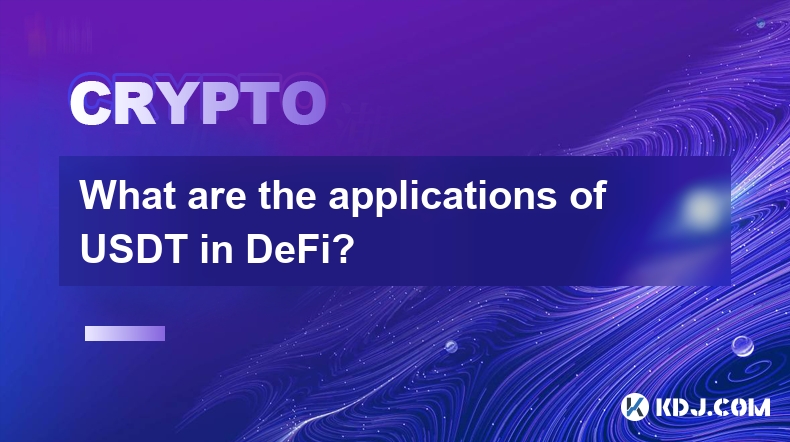
Key Points:
- USDT's role as a stablecoin in DeFi facilitates trading and reduces volatility.
- It's used extensively in lending and borrowing protocols for earning interest and leveraging positions.
- USDT is crucial for yield farming strategies aiming to maximize returns.
- It plays a significant part in decentralized exchanges (DEXs) for trading and liquidity provision.
- Risks associated with USDT usage in DeFi include smart contract vulnerabilities and the stability of Tether itself.
What are the applications of USDT in DeFi?
Tether (USDT), a prominent stablecoin pegged to the US dollar, plays a multifaceted role within the decentralized finance (DeFi) ecosystem. Its primary function stems from its relative stability compared to volatile cryptocurrencies, making it a valuable tool for various DeFi applications. This stability allows users to navigate the complexities of DeFi with reduced risk associated with price fluctuations.
One major application of USDT in DeFi is within lending and borrowing protocols. Platforms like Aave, Compound, and MakerDAO allow users to lend their USDT to earn interest, effectively acting as a savings account within the DeFi space. Conversely, users can borrow USDT against collateral, leveraging their holdings for increased trading power or other DeFi activities. The interest rates fluctuate based on supply and demand, creating a dynamic market.
Yield farming is another area where USDT shines. This popular strategy involves lending and borrowing across various DeFi protocols to maximize returns. USDT's stability makes it an ideal asset for yield farming strategies, as it minimizes the risk of significant losses from price volatility during the farming process. However, understanding the intricacies of different protocols and associated risks is crucial for successful yield farming.
Decentralized exchanges (DEXs) heavily rely on USDT for liquidity. DEXs, unlike centralized exchanges, operate without intermediaries. They require liquidity pools, which are essentially reserves of assets that facilitate trades. USDT, due to its stability and high trading volume, forms a significant component of many liquidity pools on popular DEXs like Uniswap and Curve Finance. Providing liquidity in these pools allows users to earn trading fees.
USDT is also used in various other DeFi applications. This includes decentralized stablecoin swaps, where users can exchange different stablecoins, and in DeFi-based derivatives trading, offering a relatively stable asset for hedging and speculation. The use cases continue to expand as the DeFi landscape evolves.
USDT's Role in Specific DeFi Protocols:
Let's examine USDT's function within a few key DeFi protocols:
- Aave: Aave is a prominent lending and borrowing platform. Users can deposit USDT to earn interest, or borrow USDT against other collateralized assets. The interest rates adjust based on market demand, influencing the overall profitability.
- Compound: Similar to Aave, Compound offers lending and borrowing services. Users can supply USDT to earn interest or borrow USDT using various cryptocurrencies as collateral. The platform uses a supply-and-demand mechanism to determine interest rates.
- MakerDAO: MakerDAO utilizes USDT as collateral in its Dai stablecoin system. Users can lock up USDT to mint Dai, a decentralized stablecoin. This mechanism helps maintain Dai's peg to the US dollar.
- Uniswap: Uniswap is a leading DEX. USDT is frequently paired with other cryptocurrencies in liquidity pools, allowing users to trade these assets efficiently. Liquidity providers earn trading fees proportional to their contribution to the pool.
- Curve Finance: Curve Finance is a DEX specializing in stablecoin trading. USDT is a core asset within many of its liquidity pools, facilitating efficient and low-slippage swaps between stablecoins.
Risks Associated with Using USDT in DeFi:
While USDT offers advantages within DeFi, several risks must be considered:
- Smart Contract Vulnerabilities: DeFi protocols are built on smart contracts, which are susceptible to bugs and exploits. If a vulnerability is discovered in a protocol handling USDT, users could lose their funds. Thorough audits and due diligence are essential before using any DeFi platform.
- Tether's Stability: The stability of USDT itself is a critical concern. Questions surrounding Tether's reserves and its 1:1 peg to the US dollar have raised concerns about potential de-pegging events, which could severely impact users' investments in DeFi.
- Impermanent Loss: Providing liquidity in DEXs using USDT can result in impermanent loss. This occurs when the price of the assets in the liquidity pool changes significantly, resulting in a lower value upon withdrawal compared to simply holding the assets.
Frequently Asked Questions:
Q: Is USDT the only stablecoin used in DeFi?
A: No, other stablecoins like USDC, DAI, and BUSD are also widely used in DeFi. The choice of stablecoin often depends on the specific protocol and user preferences.
Q: How safe is using USDT in DeFi?
A: Using USDT in DeFi involves inherent risks, including smart contract vulnerabilities and the potential instability of Tether itself. Thorough research and understanding of the risks are crucial.
Q: Can I lose money using USDT in DeFi?
A: Yes, it's possible to lose money using USDT in DeFi due to various factors, including smart contract vulnerabilities, market volatility, impermanent loss, and the potential de-pegging of USDT.
Q: What are the benefits of using USDT in DeFi over other cryptocurrencies?
A: USDT's primary benefit is its relative price stability compared to other cryptocurrencies, reducing the risk of significant losses due to price fluctuations. This stability is valuable in lending, borrowing, and yield farming strategies.
Q: How do I start using USDT in DeFi?
A: You'll need a cryptocurrency wallet compatible with the DeFi protocols you intend to use. You'll then need to acquire USDT, either through exchanges or other means, and transfer it to your wallet to begin interacting with DeFi applications. Always exercise caution and understand the risks involved.
Disclaimer:info@kdj.com
The information provided is not trading advice. kdj.com does not assume any responsibility for any investments made based on the information provided in this article. Cryptocurrencies are highly volatile and it is highly recommended that you invest with caution after thorough research!
If you believe that the content used on this website infringes your copyright, please contact us immediately (info@kdj.com) and we will delete it promptly.
- Coinbase, Altcoins, and Listings: What's the Buzz?
- 2025-07-01 00:30:11
- Chainlink's Bullish Signals: Investors Bet on Long-Term Value
- 2025-07-01 00:50:12
- Bybit, Kraken, and Tokenized Stocks: A New Era for Trading?
- 2025-07-01 00:30:11
- MicroStrategy, S&P 500, and Crypto News: A Wild Ride for Bitcoin and Beyond
- 2025-07-01 00:55:11
- Crypto.com & dYdX: Derivative Trading Revolutionized for Everyone
- 2025-07-01 00:35:12
- XRP Ledger EVM Sidechain Goes Live: A New Era for XRP and Web3
- 2025-07-01 00:40:12
Related knowledge
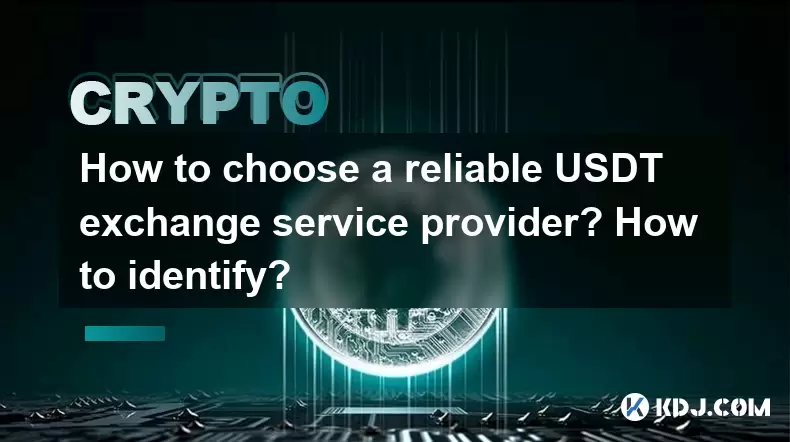
How to choose a reliable USDT exchange service provider? How to identify?
Jun 12,2025 at 03:15pm
Understanding the Role of USDT in Cryptocurrency TradingUSDT (Tether) is one of the most widely used stablecoins in the cryptocurrency market. It is designed to maintain a 1:1 peg with the U.S. dollar, offering traders and investors a way to hedge against volatility while remaining within the crypto ecosystem. Choosing a reliable USDT exchange service p...
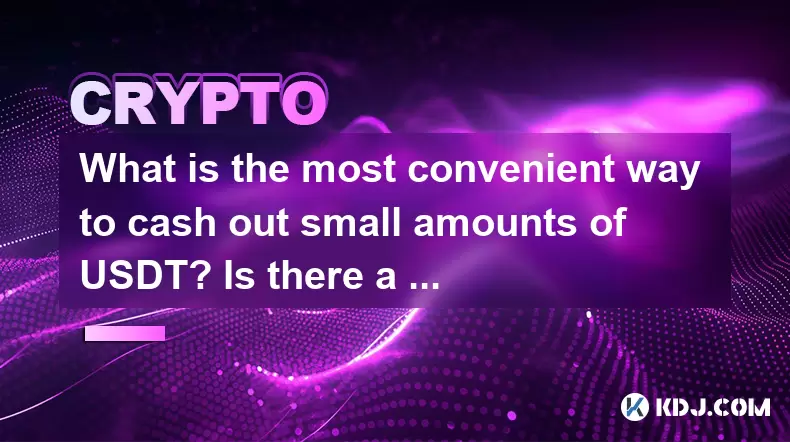
What is the most convenient way to cash out small amounts of USDT? Is there a shortcut?
Jun 11,2025 at 11:00pm
Understanding the Need to Cash Out Small USDT AmountsCashing out small amounts of USDT can be a challenge for many crypto users. Traditional methods often involve high fees, minimum withdrawal limits, or cumbersome verification processes that make it inefficient for small transactions. The key is to find a method that balances speed, cost, and convenien...
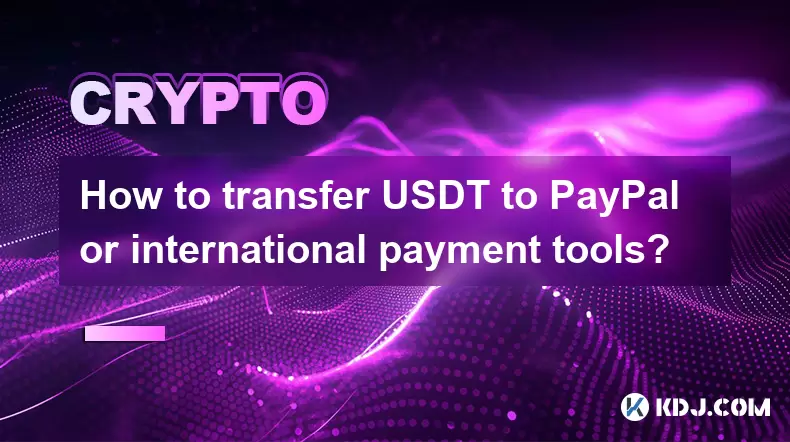
How to transfer USDT to PayPal or international payment tools?
Jun 15,2025 at 05:28am
Understanding the Basics of USDT and PayPal IntegrationUSDT (Tether) is a stablecoin pegged to the US dollar, offering blockchain-based value transfer with minimal volatility. PayPal, on the other hand, is a centralized digital wallet that facilitates fiat currency transactions globally. Direct integration between USDT and PayPal does not exist due to t...
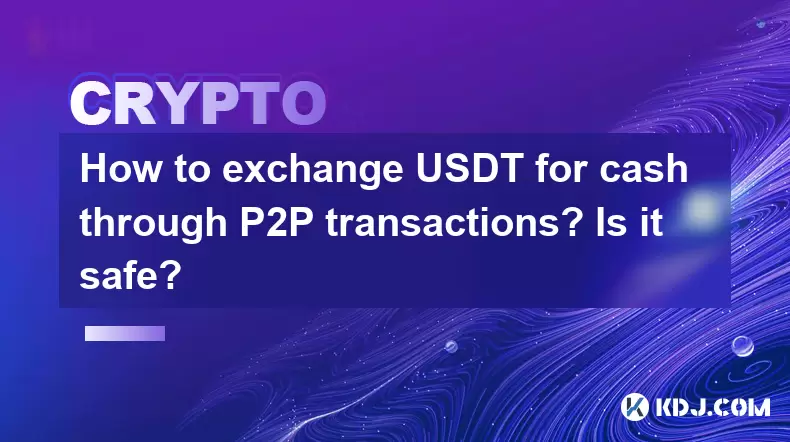
How to exchange USDT for cash through P2P transactions? Is it safe?
Jun 18,2025 at 07:56am
Understanding USDT and P2P TransactionsTether (USDT) is a stablecoin pegged to the value of the US dollar, making it a popular choice for users who want to avoid the volatility of other cryptocurrencies while still participating in the crypto ecosystem. Peer-to-peer (P2P) transactions allow individuals to trade directly with each other without going thr...
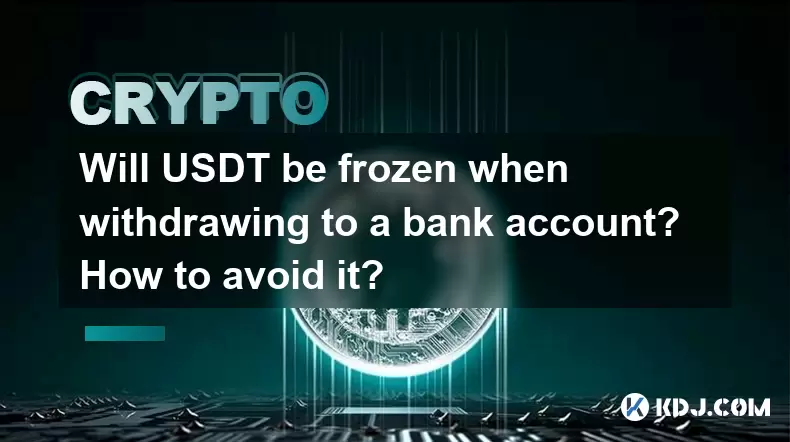
Will USDT be frozen when withdrawing to a bank account? How to avoid it?
Jun 15,2025 at 10:03am
Understanding USDT Withdrawals and Bank Account Freezing RisksWhen users decide to withdraw USDT (Tether) to a bank account, one of the most common concerns is whether their funds will be frozen during the process. This concern stems from real-life cases where individuals have encountered delays or restrictions when converting digital assets into fiat c...

How to avoid risks when exchanging USDT for cash? What are the pitfalls?
Jun 11,2025 at 08:14pm
Understanding the Risks of Exchanging USDT for CashWhen exchanging USDT (Tether) for cash, users must be aware of the potential risks involved. As a stablecoin pegged to the US dollar, USDT is widely used in crypto transactions due to its price stability. However, converting it into fiat currency like USD or CNY can expose users to several pitfalls, inc...

How to choose a reliable USDT exchange service provider? How to identify?
Jun 12,2025 at 03:15pm
Understanding the Role of USDT in Cryptocurrency TradingUSDT (Tether) is one of the most widely used stablecoins in the cryptocurrency market. It is designed to maintain a 1:1 peg with the U.S. dollar, offering traders and investors a way to hedge against volatility while remaining within the crypto ecosystem. Choosing a reliable USDT exchange service p...

What is the most convenient way to cash out small amounts of USDT? Is there a shortcut?
Jun 11,2025 at 11:00pm
Understanding the Need to Cash Out Small USDT AmountsCashing out small amounts of USDT can be a challenge for many crypto users. Traditional methods often involve high fees, minimum withdrawal limits, or cumbersome verification processes that make it inefficient for small transactions. The key is to find a method that balances speed, cost, and convenien...

How to transfer USDT to PayPal or international payment tools?
Jun 15,2025 at 05:28am
Understanding the Basics of USDT and PayPal IntegrationUSDT (Tether) is a stablecoin pegged to the US dollar, offering blockchain-based value transfer with minimal volatility. PayPal, on the other hand, is a centralized digital wallet that facilitates fiat currency transactions globally. Direct integration between USDT and PayPal does not exist due to t...

How to exchange USDT for cash through P2P transactions? Is it safe?
Jun 18,2025 at 07:56am
Understanding USDT and P2P TransactionsTether (USDT) is a stablecoin pegged to the value of the US dollar, making it a popular choice for users who want to avoid the volatility of other cryptocurrencies while still participating in the crypto ecosystem. Peer-to-peer (P2P) transactions allow individuals to trade directly with each other without going thr...

Will USDT be frozen when withdrawing to a bank account? How to avoid it?
Jun 15,2025 at 10:03am
Understanding USDT Withdrawals and Bank Account Freezing RisksWhen users decide to withdraw USDT (Tether) to a bank account, one of the most common concerns is whether their funds will be frozen during the process. This concern stems from real-life cases where individuals have encountered delays or restrictions when converting digital assets into fiat c...

How to avoid risks when exchanging USDT for cash? What are the pitfalls?
Jun 11,2025 at 08:14pm
Understanding the Risks of Exchanging USDT for CashWhen exchanging USDT (Tether) for cash, users must be aware of the potential risks involved. As a stablecoin pegged to the US dollar, USDT is widely used in crypto transactions due to its price stability. However, converting it into fiat currency like USD or CNY can expose users to several pitfalls, inc...
See all articles























